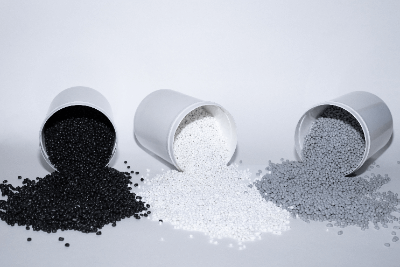What Is an Elastomer?
 An elastomer is a generic term for a polymer compound with elasticity. There are two types of elastomer: thermoplastic elastomer and thermoset elastomer.
An elastomer is a generic term for a polymer compound with elasticity. There are two types of elastomer: thermoplastic elastomer and thermoset elastomer.
Thermoplastic elastomer is fluid when heated and can be easily processed by injection molding machines. They are used in a wide range of fields, including stationery, sanitary products, and automotive parts.
Thermosetting elastomer does not deform significantly when heated, so they are utilized in situations where heat resistance is required. Typical examples are packing and sealing materials.
Uses of Elastomers
Thermoplastic elastomers are fluid when heated and can be easily processed and molded. Injection molding machines for plastics can be used to produce parts in a variety of shapes. Specifically, they are utilized for ducts, hoses, grips, etc.
Thermosetting elastomers do not become plastic when heated, so they can be used where heat resistance is required. Specifically, they are used in packing, gaskets, oil seals, etc.
Principle of Elastomers
Elastomers are a generic term for an elastic polymer, a combination of the words “elastic” and “polymer.” Elastomers are classified into thermoplastic elastomers (TPE), which soften upon heating, and thermosetting elastomers (TSE), which harden upon heating.
TPEs consist of a soft segment and a hard segment. The former plays the role of elasticity, while the latter plays the role of cross-linking. When energy is applied to the molecule by heating, the cross-linked part becomes less active and the entire molecule becomes fluid, etc. Types of TPEs include olefin (alkene), urethane, ester, styrene, and amide. Each has a different molecular structure and synthesis method.
TSEs include silicone rubber, fluoro rubber, and urethane rubber. These are the polymers referred to as rubbers. TSEs have superior properties to TPEs in terms of heat resistance and chemical resistance but are inferior to TPEs in terms of ease of processing.
Other Information on Elastomers
Dielectric Elastomers and Magnetic Elastomers
Dielectric elastomers are one of the elastomers that have been attracting attention recently. Dielectric elastomers are elastomers that produce a large strain of over several hundred percent when an electric field is applied. In other words, this device is expected to be utilized as a function of an actuator that converts electrical energy into kinetic energy according to Maxwell’s Law.
Acrylic or silicone-based materials are used for dielectric elastomers. The reason for this is that the material must have a high dielectric constant and be soft enough not to rupture under strain stress. Dielectric elastomers can be viewed as capacitor devices made of a high dielectric constant polymer material sandwiched between two electrodes. This feature is being considered for applications in the medical field, such as artificial muscles, as well as for use in various robots as highly efficient actuators.
Research and development of magnetic elastomers with viscoelasticity as another new device is also active. The new device, which combines the viscoelasticity of elastomers with the functionality of a magnetic material, can be realized by blending neodymium or iron powder with a polymer material. These devices have excellent vibration resistance and are expected to be used in mechanical actuators and seat-seat sensors for automobiles.
In addition, based on Faraday’s law of electromagnetic induction, research, and development of devices that convert kinetic energy such as vibration into electrical energy is also underway, including the dielectric elastomers mentioned above. These devices are attracting attention as part of environmental conservation efforts, as exemplified by the SDGs, and are being considered for applications in the near future, such as power generation by attaching elastomers to the soles of athletic shoes and clothing to provide power for sensor communications.